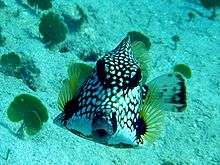Smooth trunkfish
| Lactophrys triqueter | |
|---|---|
 | |
| Scientific classification | |
| Kingdom: | Animalia |
| Phylum: | Chordata |
| Class: | Actinopterygii |
| Order: | Tetraodontiformes |
| Family: | Ostraciidae |
| Genus: | Lactophrys |
| Species: | L. triqueter |
| Binomial name | |
| Lactophrys triqueter (Linnaeus, 1758) | |
| Synonyms | |
|
Ostracion triqueter Linnaeus, 1758 | |
Lactophrys triqueter also known as the Smooth trunkfish, is a species of boxfish found on and near reefs in the Caribbean Sea, Gulf of Mexico and subtropical parts of the western Atlantic Ocean.[1]
Taxonomy
The names Lactophrys triqueter and Rhinesomus triqueter are synonymous. The former is accepted by the Encyclopedia of Life but the World Register of Marine Species [2] and FishBase [3] recognize Rhinesomus triqueter as the valid name. R. triqueter is a species of Lactophrys.[1]
Description

The smooth trunkfish has an angular body sheathed in plate-like scales, growing to a maximum length of 47 centimetres (19 in), though 20 cm (8 in) is a more normal size. The body is enclosed in a bony carapace and, when viewed from the front, is triangular in shape with a narrow top and wide base. The fish has a pointed snout with protuberant lips encircling a small mouth. The tail is shaped like a brush. The general background colour is dark with a pattern of small white spots, often in hexagonal groups giving a honeycomb-like appearance in the middle area of the body. The tip of the snout and the area round the pectoral fins are dark with few spots and the eyes are black. The fins are usually yellowish with a dark base and tips. They have only soft rays with no spines.[4][5]
The juveniles have dark coloured bodies covered in large yellow spots. As they get older, they develop a pale area where the honeycomb markings will later appear.[5]
Distribution
The smooth trunkfish is found down to a depth of about 50 m (164 ft) on coral reefs and over sandy seabeds in the Caribbean Sea, Gulf of Mexico and the western Atlantic Ocean. The range extends from Canada and the Gulf of Maine southwards to Brazil.[3]
Biology

The smooth trunkfish is normally solitary but sometimes moves around in small groups. It uses its protuberant lips to expel a jet of water which disturbs the sandy seabed and reveals any shallowly buried benthic invertebrates. It feeds on small molluscs, polychaete worms, acorn worms, peanut worms, small crustaceans, sponges and tunicates.[3][5]
Uses
In some regions, the smooth trunkfish is caught for human consumption.[3] It is also sometimes kept in reef aquaria. Caution needs to be used however as it produces a toxic substance, ostracitoxin, in mucous secretions from the skin. When the fish is stressed this is liberated into the water and some aquarium tanks and systems have been poisoned by this with the loss of all the other animal inhabitants.[6]
References
- 1 2 Matsuura, K. (2014): Taxonomy and systematics of tetraodontiform fishes: a review focusing primarily on progress in the period from 1980 to 2014. Ichthyological Research, 62 (1): 72-113.
- ↑ Bailly, N. (2010). Nicolas Bailly, eds. "Rhinesomus triqueter (Linnaeus, 1758)". FishBase. World Register of Marine Species.
- 1 2 3 4 Froese, Rainer and Pauly, Daniel, eds. (2015). "Rhinesomus triqueter" in FishBase. February 2015 version.
- ↑ Smooth trunkfish (Lactophrys triqueter) Marine Species Identification Portal. Retrieved 2012-01-01.
- 1 2 3 Lactophrys triqueter; Linnaeus, 1758 Smithsonian Tropical Research Institute. Retrieved 2012-01-01.
- ↑ The Puffers Called Box-, Cowfishes, family Ostraciidae WetWebMedia. Retrieved 2012-01-01.